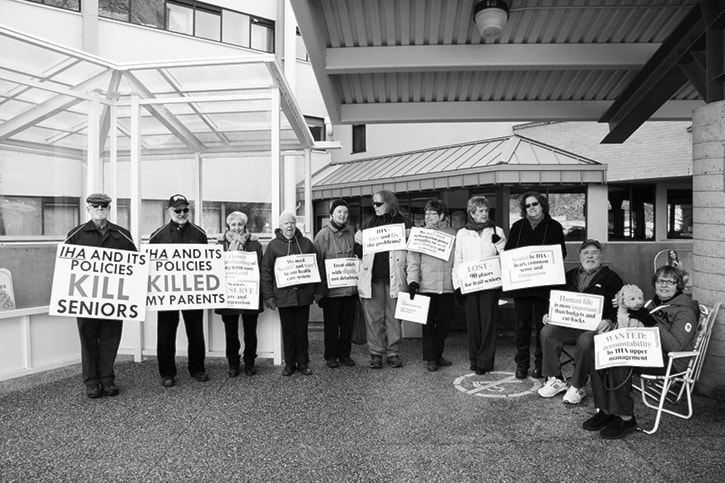Lost seniors’ services will be mourned Friday when the Society for the Protection and Care of Seniors (SPCS) hosts its annual vigil outside the Trail hospital.
The gathering from 1-3 p.m. at Kootenay Boundary Regional Hospital is more than a memorial for Carol Albo and family, who a decade later mourn the loss of Fanny Albo.
Many are familiar with of the Albo story - 91-year-old Fanny Albo was transferred in February 2006 from the Trail hospital to a facility in Grand Forks, where she died two days later, apart from her husband and family. A broken-hearted Alfie Albo, who was also a patient at KBRH when his wife of 69 years was moved, died a week later.
It’s been 10 years, and Carol notes some small improvements have been made. Interior Health (IH) has since revised its policy by ensuring family members approve patient transfers. It then provides temporary placements for seniors without removing them from a preferred residential care placement list.
There are 163 publicly funded residential care beds in Trail, a number that has held steady for the last few years, according to Karen Bloemink, executive director of Hospitals & Communities Integrated Services for IH East (Kootenays). The list is not based on first come first serve, but rather risk and urgency. IH doens’t measure the number of people waiting for a bed but does track its responsiveness in the system and claims an average wait of 34 days.
The health authority maintains it gets patients into first an appropriate bed within about 30 days before the wait then begins for preferred placement.
“That could mean living at home with extra support until we can get them into that bed or maybe they’re in the hospital, which isn’t the best scenario always for this population,” Bloemink admits.
After 30 days in a hospital bed, those waiting for residential care pay the residential rate based on the provincial guidelines (income based).
IH aims to maintain a 75-bed target per 1,000 population of individuals who are 75 years or older, which places Trail above target.
“We are well bedded in Trail,” said Bloemink.
The picture is much different from the society’s perspective, which still sees many gaps in service for the elderly, who at times require sudden extra care and support.
“IHA (Interior Health Authority) has been telling us on paper that statistically our area has way more beds than other areas, but it doesn’t really matter when the bottom line is there are not enough beds,” she said.
Since 2002, there was a dramatic loss of residential care beds with the closure of Kiro Manor and Mater Misericordiae. The intent at that time was to close those facilities and introduce enhanced services like home support, supportive housing and assisted living facilities. As a result, Silver City Gardens (supportive housing) and Rosewood Village (subsidized assisted living and complex care) were developed. Unfortunately, concerns remain in Greater Trail for anyone who is making their way through the convoluted system, according to member Margie Crawford.
“It’s only when you get into dealing with the situation when you realize the holes and the gaps and it’s all coming at you at a point when you have not the emotional or physical reserves to deal with it because you’re also dealing with your loved one,” she said. “And so to try and then go through this maze you just feel so financially and emotionally bereft.”
SPCS continues to hold the vigil to keep such gaps in services at the forefront, and to ensure IH is aware that this group of seniors will not be silenced or sit idle when it comes to respectful care needed for the aging demographic.
The group claims home support is not meeting the full needs of clients, who may require more hours of help than the public system offers and are expected to burden family and friends or acquire out-of-pocket private home care. The worry also rests with those seniors who are being housed at the hospital awaiting placement or being discharged from the hospital and returning home to minimal support since financially that’s all they can secure. A decade later, and SPCS still hears of elderly moved out of their home community in Greater Trail for temporary residential care placements in New Denver or Grand Forks.
Keeping the elderly in their home community needs to be a priority, explained Crawford.
“They’re cut off from their support network, they’re cut off from anything that’s familiar,” she said. “When everything is foreign to them, and if they have a degree of dementia, it will exasperate them dropping to another level because they’re taken out of everything that’s familiar.”
Though IH has been trying to get individuals into their first choice facility within two to three months, Crawford notes the wait time can be longer, resulting in increased stress on the client and their family.
The aging demographic is evident, according to B.C.’s Seniors’ Advocate Isobel Mackenzie’s report on Monitoring Seniors’ Services, which marks the beginning of a yearly update on key seniors’ services in the province. The report highlights where seniors’ needs are being met, and where improvements are most needed based on 2014/15 data highlighting key services under the advocate’s legislated mandate.
Home support hours decreased in three out of five health authorities, while the number of clients increased in four out of five authorities. The number of residential care beds in the province has increased by 3.5 per cent since 2012; the report notes, but the population over 75 has increased 10 per cent during that time.
“We appreciate some small improvements that have been made but we realize there are still serious needs not being met, and we need to keep this in the forefront,” said Carol, who invites the public to join the vigil outside the hospital front entrance.“It’s real, real as far as people still in need.”
